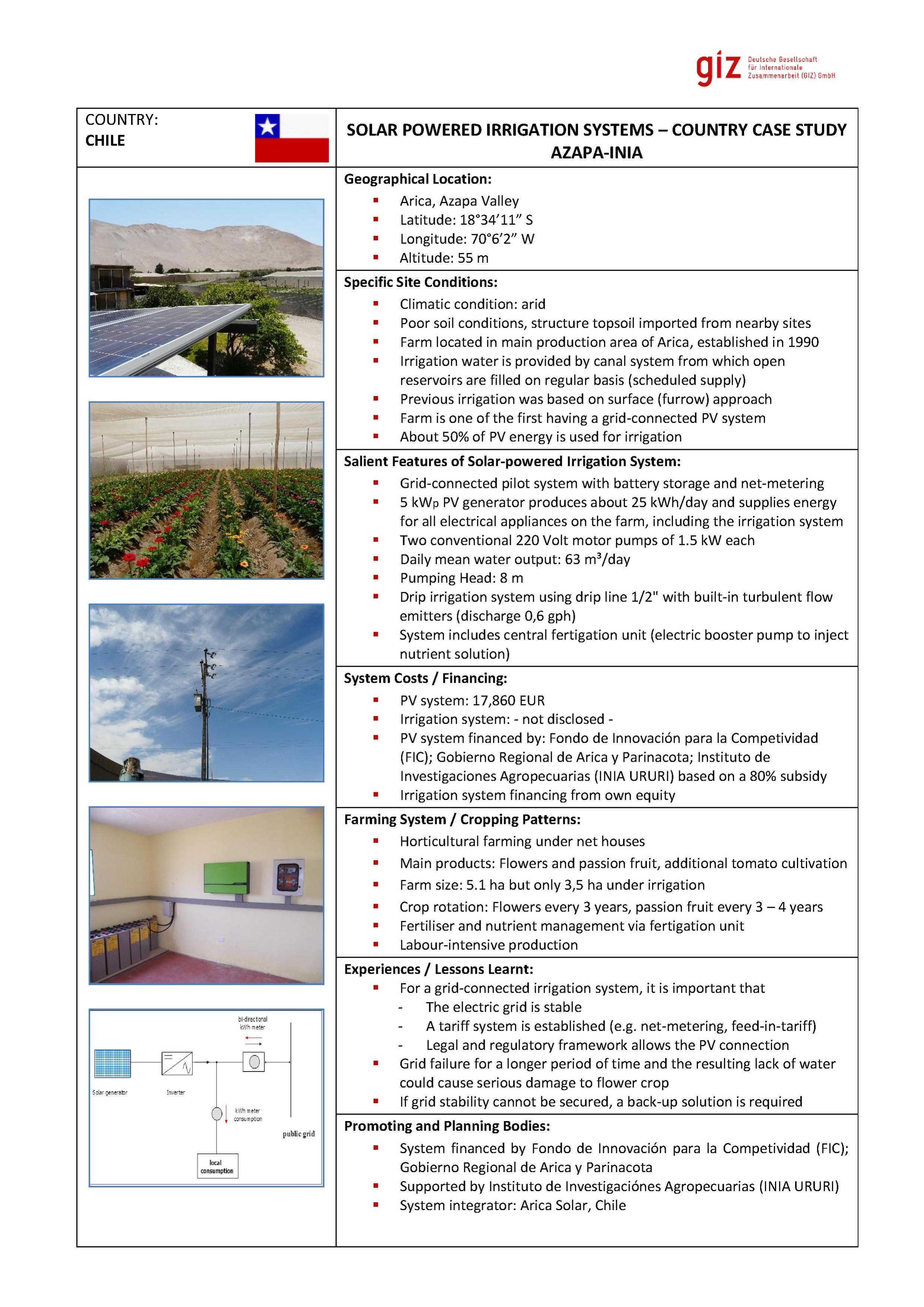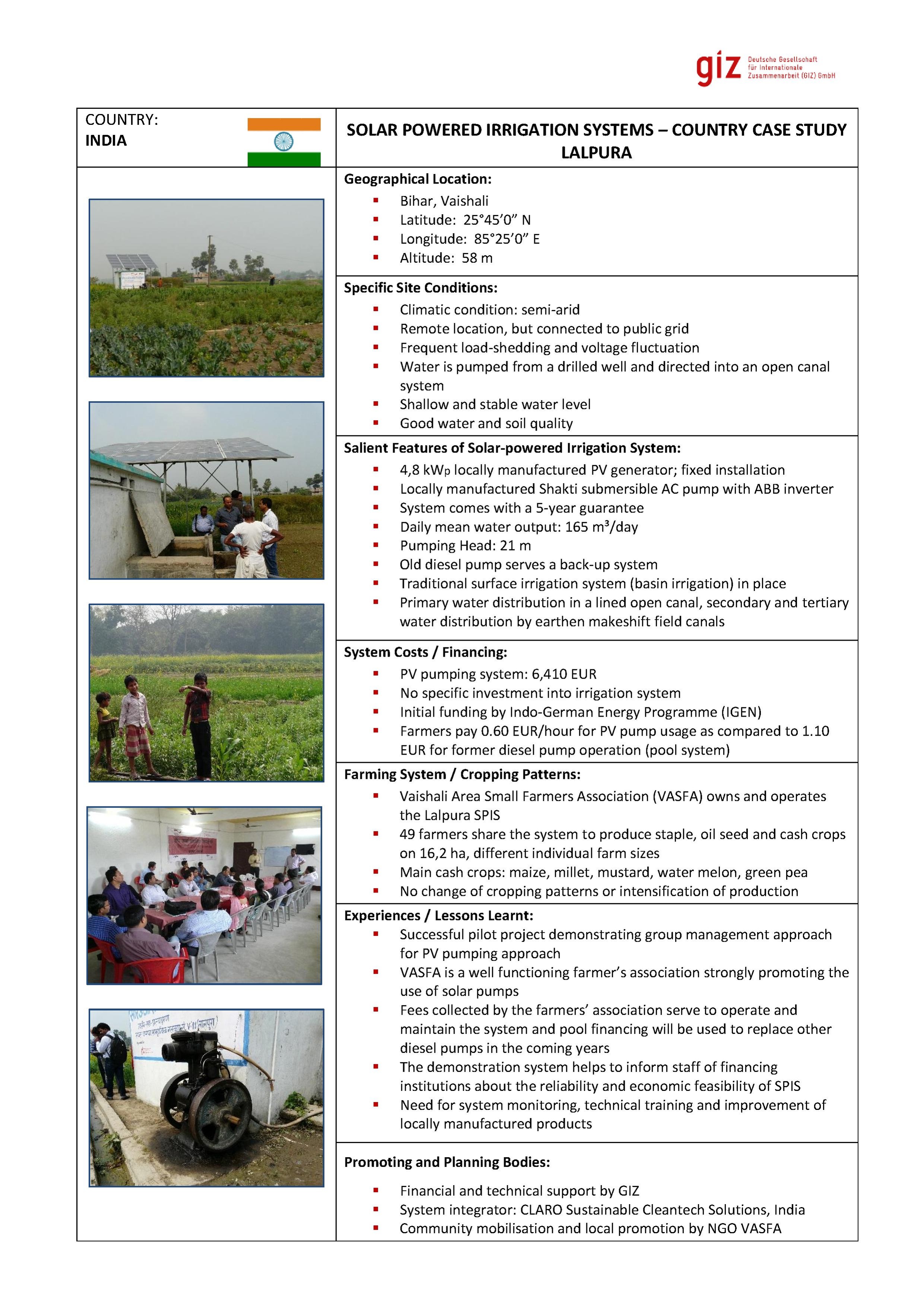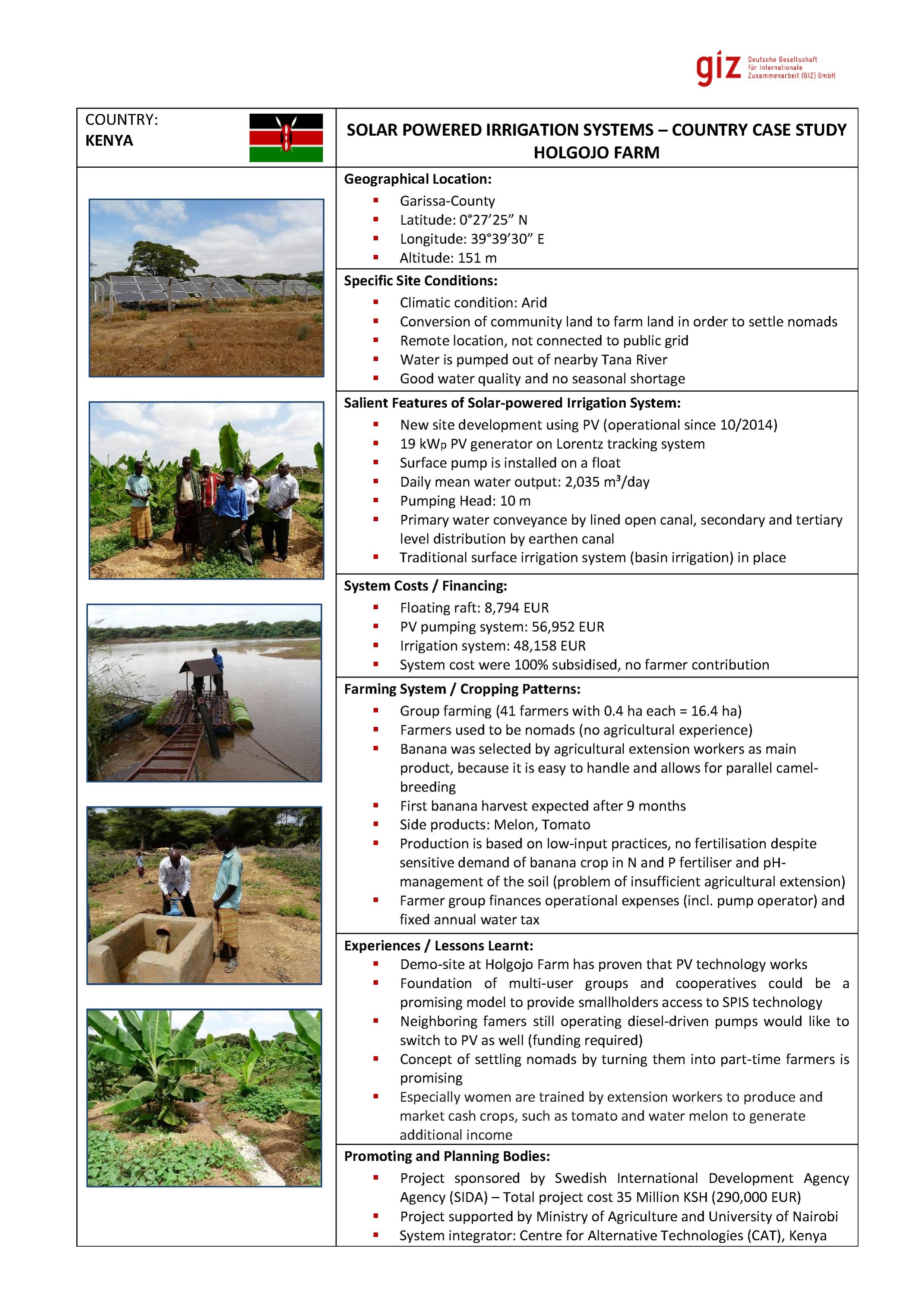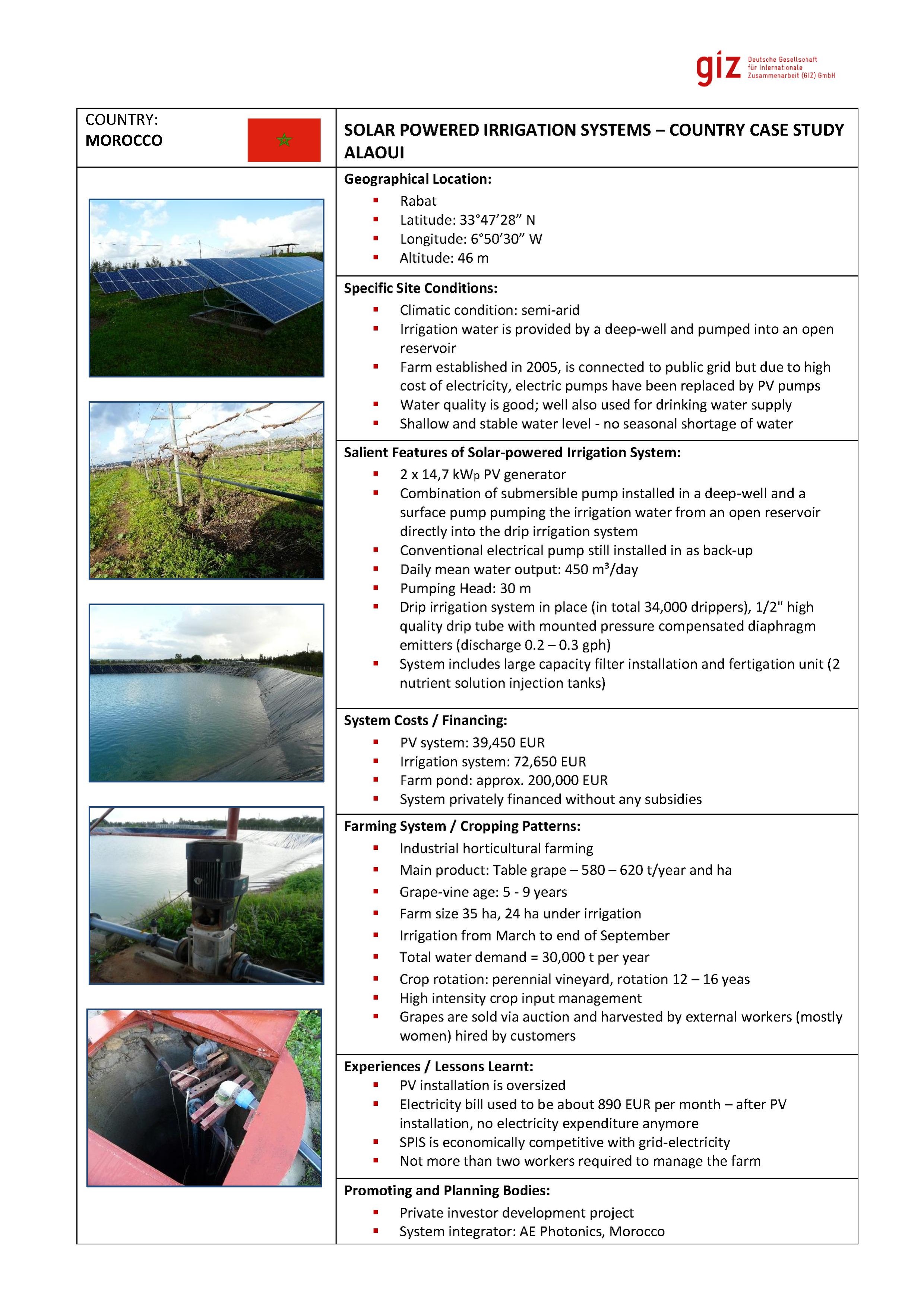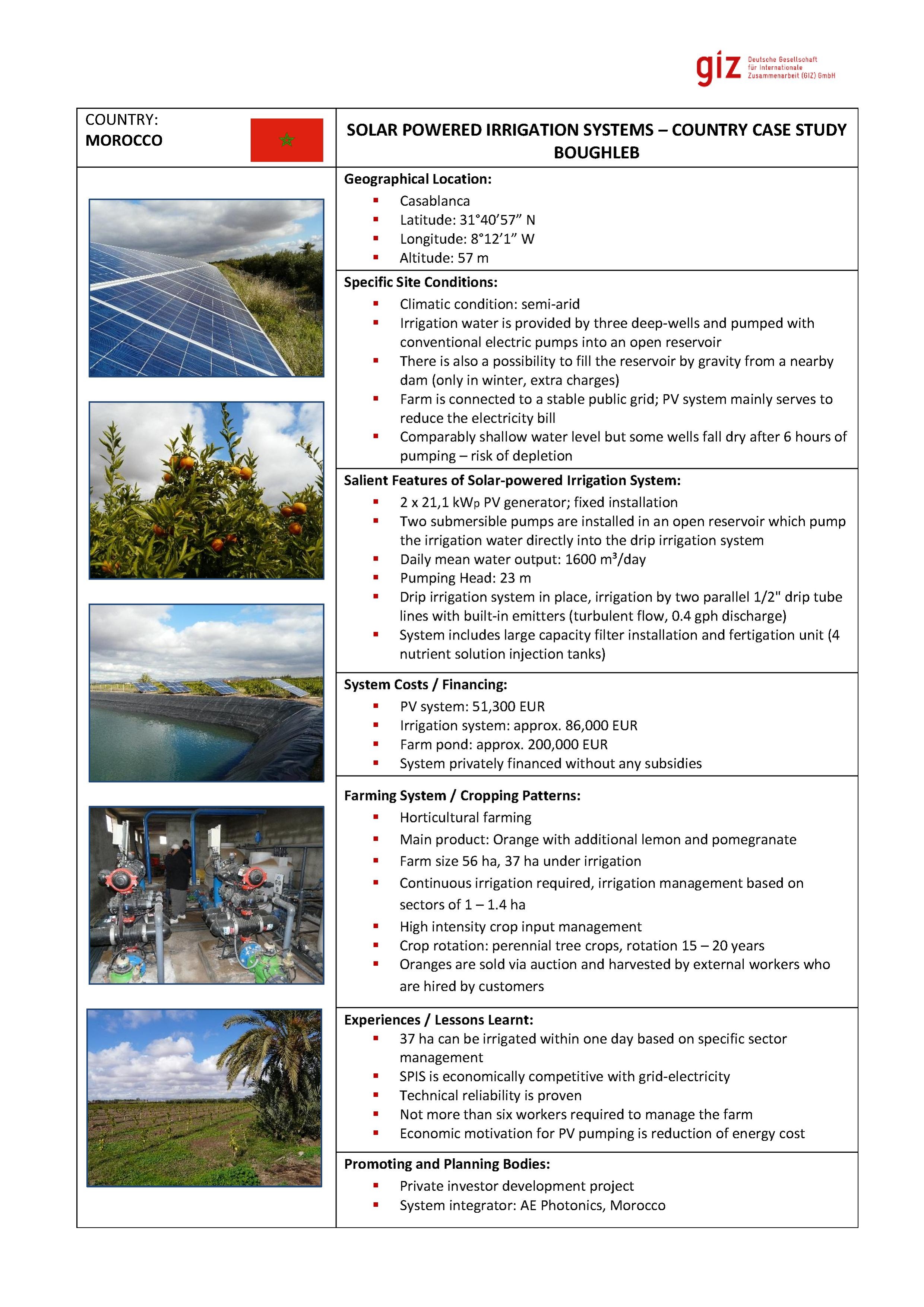Click here to register!
Difference between revisions of "Powering Agriculture: Irrigation"
***** (***** | *****) |
***** (***** | *****) |
||
| Line 8: | Line 8: | ||
The perspective of grid extension and the establishment of uninterrupted and affordable electricity supply into rural areas is a distant vision in many of these countries. [[Rural Electrification|Rural electrification]] in economically weak rural areas in Africa, Asia and Latin America will be largely based on investments into local off-grid solutions.<br/> | The perspective of grid extension and the establishment of uninterrupted and affordable electricity supply into rural areas is a distant vision in many of these countries. [[Rural Electrification|Rural electrification]] in economically weak rural areas in Africa, Asia and Latin America will be largely based on investments into local off-grid solutions.<br/> | ||
| + | <br/> | ||
= Types of Irrigation<br/> = | = Types of Irrigation<br/> = | ||
| Line 33: | Line 34: | ||
<br/>For further information on irrigation click [[Energy for Agriculture|here]] | <br/>For further information on irrigation click [[Energy for Agriculture|here]] | ||
| + | <br/> | ||
= Energy Sources for Irrigation: Water Pumping<br/> = | = Energy Sources for Irrigation: Water Pumping<br/> = | ||
| Line 62: | Line 64: | ||
== Case Studies<br/> == | == Case Studies<br/> == | ||
| − | '''Solar-Powered Pumps for Improved Irrigation in Honduras, Nepal and Zambia''': [http://www.ideorg.org/ iDE’s]''' '''Clean Irrigation Solution (CIS) can compete with fossil fuel pumps both in terms of cost and enhancing agricultural productivity. CIS’s universal piston pump can run on a variety of power sources (solar steam power, photovoltaic power, and grid-connected alternating current (AC) where available). The system accesses groundwater from deeper depths than conventional pumps, and maintains a slow, steady discharge rate. iDE will work with local businesses to sell and service the CIS. Recently, field testing of pumps have been started in Nepal. <br/> | + | '''Solar-Powered Pumps for Improved Irrigation in Honduras, Nepal and Zambia''': [http://www.ideorg.org/ iDE’s]''' '''Clean Irrigation Solution (CIS) can compete with fossil fuel pumps both in terms of cost and enhancing agricultural productivity. CIS’s universal piston pump can run on a variety of power sources (solar steam power, photovoltaic power, and grid-connected alternating current (AC) where available). The system accesses groundwater from deeper depths than conventional pumps, and maintains a slow, steady discharge rate. iDE will work with local businesses to sell and service the CIS. Recently, field testing of pumps have been started in Nepal.<br/> |
►Read more [https://poweringag.org/news/15/01/14/january-2015-newsletter here].<br/> | ►Read more [https://poweringag.org/news/15/01/14/january-2015-newsletter here].<br/> | ||
| Line 68: | Line 70: | ||
<br/> | <br/> | ||
| − | '''Micro-Solar Utilities for Small-Scale Irrigation in Senegal: '''[http://www.earth.columbia.edu/sections/view/9 Earth Institute’s] solution will enable a small group of farmers to use a central [[Solar Energy|solar energy]] unit to power multiple AC pumps for irrigation. The proposed solution takes advantage of the benefits of solar without the high costs associated with DC-powered pumps and battery storage. This power will be accessed by farmers with prepaid electricity cards issued by a micro-utility, and sold through local vendors who will benefit from a small commission. Recognizing that a major obstacle to technology adoption is [[Portal:Financing and Funding|financing]], a tariff-based financing model will allow customers to cover their appliance loans in small payments added into their micro-utility bills. <br/> | + | '''Micro-Solar Utilities for Small-Scale Irrigation in Senegal: '''[http://www.earth.columbia.edu/sections/view/9 Earth Institute’s] solution will enable a small group of farmers to use a central [[Solar Energy|solar energy]] unit to power multiple AC pumps for irrigation. The proposed solution takes advantage of the benefits of solar without the high costs associated with DC-powered pumps and battery storage. This power will be accessed by farmers with prepaid electricity cards issued by a micro-utility, and sold through local vendors who will benefit from a small commission. Recognizing that a major obstacle to technology adoption is [[Portal:Financing and Funding|financing]], a tariff-based financing model will allow customers to cover their appliance loans in small payments added into their micro-utility bills.<br/> |
| − | <span style="font-size: 13.6px | + | <span style="line-height: 20.4px; font-size: 13.6px; background-color: rgb(255, 255, 255);">►</span>Read more [[Micro-Solar Utilities for Small-Scale Irrigation in Senegal|here]].<br/> |
<br/> | <br/> | ||
| − | '''Solar Powered Irrigation Systems in Egypt and the initiative "RaSeed"''': This initiative aims to promote the use of Photovoltaic (PV) systems in drip irrigation farming in order to support cost-effective and sustainable agriculture. Therefore, the aim is to introduce high capacity solar operated water pumps - of up to a pump size of 100kW - to the Egyptian agricultural sector. Furthermore, soil in the “New Lands” is mostly sandy, and water used for irrigation is ground water. Hence, it is crucial to use water efficient irrigation systems. RaSeed targets farm specific optimization of drip irrigation systems that enable maximum fuel savings and water efficiency by taking into account soil compositions and environmental conditions. In order to further the initiative, a Private Public Partnership (PPP) was established with a solar energy firm that is supported by the multi-donor initiative: [[Powering Agriculture: An Energy Grand Challenge for Development|‘PoweringAgriculture - an Energy Grand Challenge for Development’]]. Together with its partners, RaSeed establishes a network, providing high quality solar energy technology and training in Egypt. <br/> | + | '''Solar Powered Irrigation Systems in Egypt and the initiative "RaSeed"''': This initiative aims to promote the use of Photovoltaic (PV) systems in drip irrigation farming in order to support cost-effective and sustainable agriculture. Therefore, the aim is to introduce high capacity solar operated water pumps - of up to a pump size of 100kW - to the Egyptian agricultural sector. Furthermore, soil in the “New Lands” is mostly sandy, and water used for irrigation is ground water. Hence, it is crucial to use water efficient irrigation systems. RaSeed targets farm specific optimization of drip irrigation systems that enable maximum fuel savings and water efficiency by taking into account soil compositions and environmental conditions. In order to further the initiative, a Private Public Partnership (PPP) was established with a solar energy firm that is supported by the multi-donor initiative: [[Powering Agriculture: An Energy Grand Challenge for Development|‘PoweringAgriculture - an Energy Grand Challenge for Development’]]. Together with its partners, RaSeed establishes a network, providing high quality solar energy technology and training in Egypt.<br/> |
| − | ►Read more [[ | + | ►Read more [[Solar Powered Irrigation Systems in Egypt|here]].<br/> |
<br/> | <br/> | ||
| − | <u>Further Case Studies</u>:<br/> | + | <u>Further Country Case Studies</u>:<br/> |
| + | |||
| + | *[[File:Case_Study_Chile-_Azapa_Inia.pdf|File:Case Study Chile- Azapa Inia.pdf]]<br/> | ||
| + | *[[File:Case_Study_Chile_-_La_Tirana.pdf|File:Case Study Chile - La Tirana.pdf]]<br/> | ||
| + | *[[File:Case_study_India-_Rajawas.pdf|File:Case study India- Rajawas.pdf]]<br/> | ||
| + | *[[File:Case_Study_India-_Lalpura.pdf|File:Case Study India- Lalpura.pdf]]<br/> | ||
| + | *[[Case_Study_Kenya:_Ongata-_Rongai|Case Study Kenya: Ongata- Rongai]]<br/> | ||
| + | *[[File:Case_Study_Kenya_-_Holgajo_Farm.pdf|File:Case Study Kenya - Holgajo Farm.pdf]]<br/> | ||
| + | *[[File:Case_Study_Morocco-_Alaoui.pdf|File:Case Study Morocco- Alaoui.pdf]]<br/> | ||
| + | *[[File:Case_Study_Morocco_-_Boughleb.pdf|File:Case Study Morocco - Boughleb.pdf]]<br/> | ||
| + | |||
| + | <u>Further Case Studies</u><br/> | ||
*<span dir="auto">[[Advanced Solar Irrigation Scheduling for Sustainable Rural Development: A Case of India|Advanced Solar Irrigation Scheduling for Sustainable Rural Development: A Case of India]]</span><br/> | *<span dir="auto">[[Advanced Solar Irrigation Scheduling for Sustainable Rural Development: A Case of India|Advanced Solar Irrigation Scheduling for Sustainable Rural Development: A Case of India]]</span><br/> | ||
*<span dir="auto"></span>[[Potential for Solar PV Water Pumping for Irrigation in Bihar (PA Project)|Potential for Solar PV Water Pumping for Irrigation in Bihar]]<br/> | *<span dir="auto"></span>[[Potential for Solar PV Water Pumping for Irrigation in Bihar (PA Project)|Potential for Solar PV Water Pumping for Irrigation in Bihar]]<br/> | ||
*[[Techno-Economic Feasibility of PV Irrigation in Egypt|Techno-Economic Feasibility of PV Irrigation in Egypt]]<br/> | *[[Techno-Economic Feasibility of PV Irrigation in Egypt|Techno-Economic Feasibility of PV Irrigation in Egypt]]<br/> | ||
| − | *[https://energypedia.info/images/4/46/Potential_of_Solar_Irrigation_Water_Pumps_in_Pakistan.pdf Potential of Solar Irrigation Water Pumps in Pakistan] | + | *[https://energypedia.info/images/4/46/Potential_of_Solar_Irrigation_Water_Pumps_in_Pakistan.pdf Potential of Solar Irrigation Water Pumps in Pakistan]<br/> |
| + | |||
| + | <br/> | ||
= Further Information<br/> = | = Further Information<br/> = | ||
| Line 98: | Line 113: | ||
*[http://www.climatetechwiki.org/technology/jiqweb-swp Climate Tech Wiki: Solar Water Pumps]<br/> | *[http://www.climatetechwiki.org/technology/jiqweb-swp Climate Tech Wiki: Solar Water Pumps]<br/> | ||
| + | [[Category:Solar_Pumping]] | ||
| + | [[Category:Agriculture]] | ||
| + | [[Category:Irrigation]] | ||
| + | [[Category:Productive_Use]] | ||
[[Category:Powering_Agriculture]] | [[Category:Powering_Agriculture]] | ||
| − | |||
| − | |||
| − | |||
| − | |||
Revision as of 14:37, 22 September 2015
Agriculture is the backbone of the majority of developing and emerging countries. Therefore, access to reliable and affordable irrigation water for agriculture is a crucial factor for the economic development of the country.
Background
Manual lifting of irrigation water significantly reduces the scope of cultivation and the efficiency of irrigation – it does not, for example, allow for pressurized systems that are required for water saving drip or sprinkler irrigation techniques. In the absence of reliable electricity supply due to lack of grid connection or intermittent service, farmers in developing countries have hence to rely often on diesel-driven pumps for water abstraction and conveyance. These diesel-driven pumps create high operation costs and are prone to service gaps due to an insufficient fuel supply and technical defects. A reliable and cost-effective supply of irrigation water is therefore a core problem in many rural areas in developing and emerging countries.
The perspective of grid extension and the establishment of uninterrupted and affordable electricity supply into rural areas is a distant vision in many of these countries. Rural electrification in economically weak rural areas in Africa, Asia and Latin America will be largely based on investments into local off-grid solutions.
Types of Irrigation
There are various types of irrigation methods, each requiring an experienced farmer to determine the quantity of water to apply and the timing of the irrigation. The most commonly used modern irrigation methods are:
- Surface irrigation. Types:
- Borders (strips of land are irrigated)
- Furrows (water is fed into small channels)
- Basin irrigation (entire field is flooded)
- Borders (strips of land are irrigated)
- Sprinkler irrigation
- Drip irrigation
A number of factors determine the suitability of the various methods:
- Natural conditions: soil type, slope, climate, water availability, water quality
- Type of crop
- Type of technology
- Previous experience with irrigation
- Capital requirements and availability
- Costs and benefits
- Labour input
For further information on irrigation click here
Energy Sources for Irrigation: Water Pumping
Motor-driven water abstraction and conveyance requires a reliable energy source – or a reliable combination of energy sources. The vast majority of water pumping for irrigation purposes is to date done by diesel or petrol motors as well as by electric motors that fed from the grid or are run by diesel generators. The utilization of renewable energy sources is steadily increasing but still on the minority side.
The most commonly used energy sources for irrigation water pumping:
- Petrol engine
- Diesel engine
- Natural gas engine
- Electric engine: distinction has to be made according to the actual source of electricity
- Network/grid-supplied electricity
- Generator (diesel, petrol)-supplied electricity
- PV-generated electricity
- Electricity generated from other off-grid RE sources (biogas, biomass generators)
- Wind powered pumps
Solar-powered Irrigation Systems
In regions with high solar insolation levels, electricity from solar cells has created new options for lifting and distributing water in an efficient, reliable, economically viable as well as ecological-sound way.
Nevertheless, the technological option of solar-powered irrigation is rarely taken into consideration due to a lack of pertinent experience and the comparably high investment costs of the past. Nevertheless, as prices for solar modules have fallen substantially in recent years, governments, extension services and technical cooperation are reconsidering PV water pumps to be employed in agricultural production and beyond. However, demand in this regard will have to be largely generated from the rural farm households themselves.
Barriers
- Farmers and extension services are not aware of the variety of new technologies that may be appropriate for them
- CES (clean energy technologies) are relatively new, therefore farmers have limited access to distributors for installation, parts, and service
- Farmers often do not have the means to cover high capital costs associated with clean energy upgrades – and financing is seldom available
Case Studies
Solar-Powered Pumps for Improved Irrigation in Honduras, Nepal and Zambia: iDE’s Clean Irrigation Solution (CIS) can compete with fossil fuel pumps both in terms of cost and enhancing agricultural productivity. CIS’s universal piston pump can run on a variety of power sources (solar steam power, photovoltaic power, and grid-connected alternating current (AC) where available). The system accesses groundwater from deeper depths than conventional pumps, and maintains a slow, steady discharge rate. iDE will work with local businesses to sell and service the CIS. Recently, field testing of pumps have been started in Nepal.
►Read more here.
Micro-Solar Utilities for Small-Scale Irrigation in Senegal: Earth Institute’s solution will enable a small group of farmers to use a central solar energy unit to power multiple AC pumps for irrigation. The proposed solution takes advantage of the benefits of solar without the high costs associated with DC-powered pumps and battery storage. This power will be accessed by farmers with prepaid electricity cards issued by a micro-utility, and sold through local vendors who will benefit from a small commission. Recognizing that a major obstacle to technology adoption is financing, a tariff-based financing model will allow customers to cover their appliance loans in small payments added into their micro-utility bills.
►Read more here.
Solar Powered Irrigation Systems in Egypt and the initiative "RaSeed": This initiative aims to promote the use of Photovoltaic (PV) systems in drip irrigation farming in order to support cost-effective and sustainable agriculture. Therefore, the aim is to introduce high capacity solar operated water pumps - of up to a pump size of 100kW - to the Egyptian agricultural sector. Furthermore, soil in the “New Lands” is mostly sandy, and water used for irrigation is ground water. Hence, it is crucial to use water efficient irrigation systems. RaSeed targets farm specific optimization of drip irrigation systems that enable maximum fuel savings and water efficiency by taking into account soil compositions and environmental conditions. In order to further the initiative, a Private Public Partnership (PPP) was established with a solar energy firm that is supported by the multi-donor initiative: ‘PoweringAgriculture - an Energy Grand Challenge for Development’. Together with its partners, RaSeed establishes a network, providing high quality solar energy technology and training in Egypt.
►Read more here.
Further Country Case Studies:
Further Case Studies
- Advanced Solar Irrigation Scheduling for Sustainable Rural Development: A Case of India
- Potential for Solar PV Water Pumping for Irrigation in Bihar
- Techno-Economic Feasibility of PV Irrigation in Egypt
- Potential of Solar Irrigation Water Pumps in Pakistan
Further Information
- Solar Energy for Powering Agriculture
- Promotion of Solar-Powered Irrigation Systems (SPIS) - Workshop Documentation
- Photovoltaic (PV) Pumping Systems for Irrigation
- Article on Agriwaterpedia
- Entry in PoweringAg Technology Database: Appropriate Irrigation
- Entry in PoweringAg Technology Database: Smart Irrigation Controls
- Practical Action: Fact sheet on the advantages and disadvantages of solar photovoltaic water pumping, including real world application.
- Climate Tech Wiki: Solar Water Pumps

